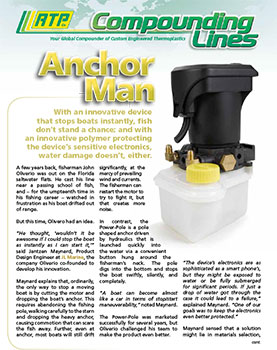Search Case Studies
With an innovative device that stops boats instantly, fish don’t stand a chance; and with an innovative polymer protecting the device’s sensitive electronics, water damage doesn’t, either.
A few years back, fisherman John Oliverio was out on the Florida saltwater flats. He cast his line near a passing school of fish, and—for the umpteenth time in his fishing career—watched in frustration as his boat drifted out of range. But this time, Olivero had an idea.
“He thought, ‘wouldn’t it be awesome if I could stop the boat as instantly as I can start it,’” said Jantzen Maynard, Product Design Engineer at JL Marine, the company Oliverio co-founded to develop his innovation.
Maynard explains that, ordinarily, the only way to stop a moving boat is by cutting the motor and dropping the boat’s anchor. This requires abandoning the fishing pole, walking carefully to the stern and dropping the heavy anchor, causing commotion that can scare the fish away. Further, even at anchor, most boats will still drift significantly, at the mercy of prevailing wind and currents. The fisherman can restart the motor to try to fight it, but that creates more noise.
In contrast, the Power-Pole is a pole shaped anchor driven by hydraulics that is launched quickly into the water via a convenient button hung around the fisherman’s neck. The pole digs into the bottom and stops the boat swiftly, silently, and completely.
“A boat can become almost like a car in terms of stop/start maneuverability,” noted Maynard.
The Power-Pole was marketed successfully for several years, but Oliverio challenged his team to make the product even better.
“The device’s electronics are as sophisticated as a smart phone’s, but they might be exposed to water or be fully submerged for significant periods. If just a drop of water got through the case it could lead to a failure,” explained Maynard. “One of our goals was to keep the electronics even better protected.”
Maynard sensed that a solution might lie in materials selection, noting that, at the time, the company was using the glass reinforced nylon suggested by their compounder. He and his team decided to take a polymer science class at the University of Massachusetts to learn more.
“The class really opened our eyes to the huge universe of polymer performance possibilities. At the time, it seemed, we were using the best polymer for the application that the supplier happened to sell, rather than the best polymer for the application period,” recalled Maynard. “We knew we wanted to work with a compounder that had a wide selection of base polymers and the expertise to apply them optimally.”
After some research, he put in a call to RTP Company. The difference, he notes, was immediately apparent.
“RTP Company doesn’t just offer a handful of base polymers—it seems like they have every commercially viable base polymer known to man, and with all the additives they can apply, their solutions are nearly infinite,” said Maynard. “In addition, they offer specialized engineering expertise to help specify and optimize solutions, not just sales representatives with limited scientific knowledge.”
RTP Company engineers pointed them toward glass-reinforced Polybutylene Terephthalate (PBT), a thermoplastic engineering polymer used as an insulator in the electrical and electronics industries.
“There’s a whole gamut of ways that a polymer could fail in this application and the RTP Company compound is successfully addressing every one of them,” said Maynard. “It has low moisture absorption, excellent electrical resistance, great dimensional stability, creep resistance and more.”
Extensive lab testing and early field testing has resulted in zero failures, even better than any prior performance, Maynard noted. Further, JL Marine is enjoying an unexpected aesthetic benefit as well.
“Unlike nylon, the PBT is really glossy with no strands of glass visible—it looks great and it’s going to give us a further marketing advantage,” he said.
According to Maynard, the success of this project has made RTP Company their go-to partner, with numerous other projects now underway.
“We’re not getting plastic from anyone else from now on,” Maynard explains. “Here’s a company that has so many different polymers and so much expertise that they’re always going to steer you in the right direction, not just to something they happen to have on the shelf. That’s the kind of company we can trust.”





